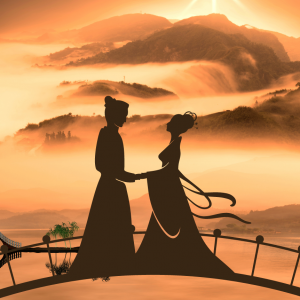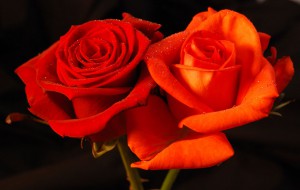“Citizens followed the tradition of several variations to ensure the success of continuing their long line of descendants…”
Have you ever been fascinated by those old Chinese weddings you see on cable or sometimes in the movies? Maybe you are horrified at the thought of parents arranging their child’s marriage without them a choice! Perhaps even your own Chinese grandparents had experienced them, which makes you wonder how they lived together through the years. Don’t worry; the old Chinese had their own ways to ensure their happiness as couples born on the “arranged marriage” era, strange as they may be.
The system of this tradition was created and exercised from 402–221 B.C., during the Warring States Period1, over 2400 years ago. Citizens followed this tradition of several variations to ensure the success of continuing their long line of descendants, their primary objective and the alliance between families, although the traditions and effort behind it were quite tedious.
The motif of these weddings was always bright, glossy red similar to the English weddings of pure white. Surprisingly, everything was arranged by the parents while the bride and groom had absolutely no say in the matters of their own wedding.
The Proposal
The boy’s parents search for a prospective daughter-in-law. Once they do, the boy’s parents arrange a proposal to the girl’s parents and send a matchmaker to present their offer to the other family to see how they feel about the match. If the girl’s parents accept, the matchmaker will give the girl’s birth date for the boy’s family to keep. If for three days, no bad omen (e.g. quarrel, money loss, etc.) happens to either of the families then both sets of parents would meet and assess each other’s social, financial and educational statuses. Only if both parties are satisfied will they truly agree to let their children unite. That is when they proceed to the betrothal.
The Betrothal
Commonly lasting for about a year, the bot’s family gives gifts such as tea and bridal cakes to the girl’s family together with the betrothal letter. The girl will then accept this and distribute the bridal cake to her family and friends, which also serves as an announcement and invitation to the wedding. Later, the boy would send formal wedding gifts. These may include tea, seeds, beans, red dates, nutmeg, fruits, lily, wine, red hair braid, a money box and other stuff, depending on local customs and the wealth of the boy’s family. After a few days, the girl’s family would then send a dowry, consisting of practical items for household use, to the boy’s family. The picked wedding date must be promising and favorable according to the astrologer.
The Day Before the Wedding
A bridal bed would be installed, chosen by the “good luck” man and “good luck” woman. The “good luck” couple is chosen by both families, after seeing the good fortune of these spouses in raising children and living a healthy life. The act of the “good luck” couple of choosing and installing the bed would be to represent passing on their luck to the newlyweds. The children would then be invited to that same bed. They belied that, in doing so, this would invite fertility and happiness to the couple.
Trivia:
Double happiness (囍): The double happiness symbol (pronounced shuang-xi in Mandarin) is a special Chinese character used for marital happiness.
The Day of the Wedding
The bride would have her hair dressing ritual prepared by the same “good luck” woman. She would have to take a bath in a tub of water and pomelo juice to “cleanse and wash away the evil spirits” and also to soften her skin. With Dragon-and-Phoenix candles around the room, the bride wears her red wedding dress, red shoes, red silk veil with the phoenix crown once her hair is finished being styled by the “good luck” woman. She then bows to her family then to her ancestors while waiting for the groom.
The groom, on the other hand, would have a capping ritual. First he would put on his wedding clothes with a red silk sash and ball tied to his torso then his father would place a cap on his head decorated with cypress leaves in front of the family altar. The groom would bow down to heaven and Earth, to his ancestors and then to his family. The father would then remove the silk ball and place it on the bridal chair or a decorated donkey, if they were poor.
The groom would then travel to the girl’s house and pick up his bride. Many escorts, some of which make happy noises with drums, firecrackers, lyres, trumpets and lion dances, would accompany him. Others carried the bridal chair with a child included to symbolize the groom’s desire to have children.
When the parading troops arrives at the bride’s home, firecrackers would be set off to hail the groom’s arrival. The bridesmaids and even the matchmaker would then demand some angpao (red packets containing money) before letting the groom in. After that the groom would eat eggs with the bride’s family to represent the bride’s breaking ties with her family.
“Others carried the bridal chair with a child included to symbolize the groom’s desire to have children”
When the bride comes out, the “good luck” woman would then carry her to the bridal chair. The bridegroom is not allowed to see her. This chair would be heavily covered in curtains to prevent her from seeing certain forms that would constitute bad luck (e.g. seeing a widow). Then the party would return to the groom’s house for the wedding itself, with the parade as noisy as that during the arrival of the groom.
The Wedding
Despite all the tedious procedures, preparations and rituals, the wedding itself is very simple. The bride and groom are led to the family alter and bow to Heaven and Earth, to the ancestors and to the parents before bowing to each other. Sometimes the ritual had them drink wine from the same cup. Having done this, they would be proclaimed man and wife. The groom would then be allowed to lift the bride’s veil and see his wife for the first time.
After the wedding, they would go to the bridal chamber. Visitors are invited to come in to tease the newlyweds so as to help ease the tension or to play games wherein the newlyweds have to act as husband and wife.
The day after the wedding, the newlywed bride would formally meet and be received by the groom’s family as one of their own. Three days after, the newlyweds would visit the girl’s family but she would now sit as a guest. Finally, each family gives separate feast to their own relatives and friends to celebrate the union of their children.
Written by Eiza Chua.
Originally published in Chinoy Volume. 6, Issue 1, pp. 6–7. Edited to accommodate the current Elements style guide.





Pingback: Stories and Issues: Reads for Chinese Valentine's Day - Elements Magazine